You are using an out of date browser. It may not display this or other websites correctly.
You should upgrade or use an alternative browser.
You should upgrade or use an alternative browser.
Adding storage to my Enphase system
- Thread starter GXMnow
- Start date
GXMnow
Solar Wizard
- Joined
- Jul 17, 2020
- Messages
- 2,713
My system hit a new milestone today. The NewPowa panels an Bouge RV charge controller exceeded 4,000 watt hours. It was fairly cool today, so the panels performed better, and there were virtually no clouds as well. I started typing this at 5:50 pm, and both the SilFab / Enphase and the NewPowa / Bouge RV systems are still making a little bit of power, but the fun part is, the 4,800 watts going into the Enphase system is making virtually the same power as the 1,000 watts going into the Bouge. Both are showing 20 watts. The sun is very low in the sky, there is a huge shadow across half of the SilFab panels, and all production will be done very soon. And sure enough, at 5:54 the Enphase system reported zero power. The Bouge is down to 13 watts. I have to wait abut 6 more minutes for Enphase Enlighten to update for the total watt hours today. The Bouge is still counting up, but it is basically done at 4,019 watt hours with only 0.27 amps still going into the battery system. Since the Enphase is no longer helping, the XW-Pro is pulling 11 amps out of the batteries, so the small current from the DC panels is just barely slowing the discharge now.
Here are a couple interesting pictures.

It's a little hard to see in this picture, but when I took that at 4:36 pm, the front row of panels is casting a shadow onto the very bottom row of cells of the back row. So I think from even before this, I was pretty much down to just the front row doing all of the work.
I have not changed the settings in the XW-Pro yet. It is still set to charge to 56.98 volts. With the help of the DC charging, it hit 56.9 volts by just 12:37 pm. At that point, I cap the max charge rate to 25% from the XW. But with the 25% still, and 12 amps coming from the DC charging, it only took 11 minutes to get to the 56.98 volt Bulk Charge limit, so the XW fell down to absorb, and the Enphase power started exporting over 2,000 watts. Absorb only lasted 6 minutes until it saw the voltage was holding with the current down to zero. Here is the graph as of 6:13 pm
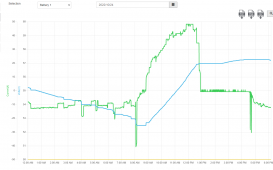
But this graph also shows something else. At 2:35 pm, more than 1.5 hours after the XW stopped it's charging, the battery voltage, being reported by the XW stats to show the voltage climbing. The DC panels are really doing their job here. Since the old solar panels are still fully powering the house, the battery bank is under essentially no load and even the small 8 to 10 amps coming in from the small DC array is enough to keep them charging higher. Now, I still don't want to push then too high, but this is not enough for concern. The original rating for these cells it 4.2 volts per cell which would be 58.8 volts for the 14S battery bank. I se the Bouge charge controller to 57.6 volts to keep it from going back to BOOST mode. The highest voltage the XW reports for the battery is 57.25 volts, and the BMS showed it at 57.20 volts. The Bouge RV charge controller was showing 57.4 with a peak reading showing 57.5 volts. Each cell in my old battery bank, with the JK BMS was showing from 4.085 to 4.087 volts, yes just 0.002 volts from lowest to highest cell. And the BMS is reporting that as 92% charged.

That was back at 4:32 while the DC panels were still making a little power, charging at 1.2 amps into the old bank, a little more is going into the new bank as well. But that is the highest voltage reading I was able to capture. Shortly after 6 pm, the voltage starts dropping as the XW starts using battery power to run my house. Here is the 1,000 watt array again as the power fell to 10 watts, look how the shadows are barely visible under the panels, it is just the light scatter in the clouds making that little power.
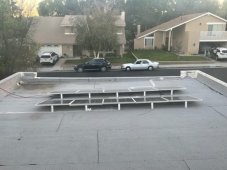
And as the Bouge controller finally shuts down, the total DC charge power fo the day ended at...
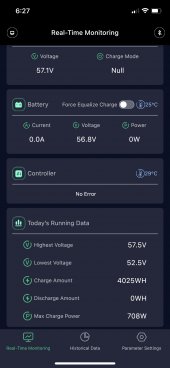
4,025 watt hours. Peak power hit 706 watts. 70.6% of array rating, and 4.025 Sun Hours of production.
Meanwhile, here is the final production for the Enphase panels today.
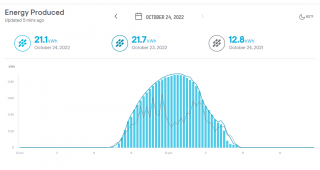
Peak power averaged for 15 minutes hit 3,500 watts or 72.9% of the panel rating, so still beats the DC setup there. And total energy for the day hit 21.1 KWH out of 4.8 KW of panels for 4.396 sun hours, again, still beating the DC system. It has been pretty consistent, the new DC setup is getting just 91.6% of the sun hours of the old panels. My guess is that both the NewPowa panels and the Bouge charge controller are only getting 96% of their ratings. That is within the "fudge factor" range on a spec sheet, within 5%. So the panels are really just 95 watts, and the 98% efficient charge controller is really just 92% efficient. They might be a tick better than that, and my angles and the shadows are holding it back a hair, but even if that is the best they can do, it is decent for the price to my door, with the free shipping etc. This is a lot better than you get with a lot of the cheaper Chinese made stuff out there. And it also goes to show that my higher tier SilFab Enphase equipment is holding up just fine after 3 years in the hot So Cal sun.
I am temped to take over one of the SilFab panels for a day and see how it performs on the Bouge charge controller. I just don't think I have enough cable to reach the old array, and I don't want to move the panels. If I also then connect 4 of the new panels to the Enphase inverter in series parallel, it should work fine, but by my math, it will clip the iQ7 inverter. The peak sun I got today, even saying they are 95 watt panel, the power of 4 could hit 277 watts. It won't hurt the inverter, but it should clip it at 240 watts for over an hour. But that might not tell me the peak power capability. I would get less power, but a more realistic measure if I series just 2 panels alone. Then the peak power will be around 139 watts. The maximum input voltage of the iQ7 is 48 volts, 2 of these panels will only total up to 45 volts. MPPT tracking range is 27 to 37 volts. I was seeing 80 to 90 volts for 5 panels in MPPT mode on the Bouge. That works out to 32 to 36 volts for a series pair. So it should gather every watt. This experiment could tell me if the panels are week, or the charge controller is not efficient.
Here are a couple interesting pictures.

It's a little hard to see in this picture, but when I took that at 4:36 pm, the front row of panels is casting a shadow onto the very bottom row of cells of the back row. So I think from even before this, I was pretty much down to just the front row doing all of the work.
I have not changed the settings in the XW-Pro yet. It is still set to charge to 56.98 volts. With the help of the DC charging, it hit 56.9 volts by just 12:37 pm. At that point, I cap the max charge rate to 25% from the XW. But with the 25% still, and 12 amps coming from the DC charging, it only took 11 minutes to get to the 56.98 volt Bulk Charge limit, so the XW fell down to absorb, and the Enphase power started exporting over 2,000 watts. Absorb only lasted 6 minutes until it saw the voltage was holding with the current down to zero. Here is the graph as of 6:13 pm

But this graph also shows something else. At 2:35 pm, more than 1.5 hours after the XW stopped it's charging, the battery voltage, being reported by the XW stats to show the voltage climbing. The DC panels are really doing their job here. Since the old solar panels are still fully powering the house, the battery bank is under essentially no load and even the small 8 to 10 amps coming in from the small DC array is enough to keep them charging higher. Now, I still don't want to push then too high, but this is not enough for concern. The original rating for these cells it 4.2 volts per cell which would be 58.8 volts for the 14S battery bank. I se the Bouge charge controller to 57.6 volts to keep it from going back to BOOST mode. The highest voltage the XW reports for the battery is 57.25 volts, and the BMS showed it at 57.20 volts. The Bouge RV charge controller was showing 57.4 with a peak reading showing 57.5 volts. Each cell in my old battery bank, with the JK BMS was showing from 4.085 to 4.087 volts, yes just 0.002 volts from lowest to highest cell. And the BMS is reporting that as 92% charged.

That was back at 4:32 while the DC panels were still making a little power, charging at 1.2 amps into the old bank, a little more is going into the new bank as well. But that is the highest voltage reading I was able to capture. Shortly after 6 pm, the voltage starts dropping as the XW starts using battery power to run my house. Here is the 1,000 watt array again as the power fell to 10 watts, look how the shadows are barely visible under the panels, it is just the light scatter in the clouds making that little power.

And as the Bouge controller finally shuts down, the total DC charge power fo the day ended at...

4,025 watt hours. Peak power hit 706 watts. 70.6% of array rating, and 4.025 Sun Hours of production.
Meanwhile, here is the final production for the Enphase panels today.

Peak power averaged for 15 minutes hit 3,500 watts or 72.9% of the panel rating, so still beats the DC setup there. And total energy for the day hit 21.1 KWH out of 4.8 KW of panels for 4.396 sun hours, again, still beating the DC system. It has been pretty consistent, the new DC setup is getting just 91.6% of the sun hours of the old panels. My guess is that both the NewPowa panels and the Bouge charge controller are only getting 96% of their ratings. That is within the "fudge factor" range on a spec sheet, within 5%. So the panels are really just 95 watts, and the 98% efficient charge controller is really just 92% efficient. They might be a tick better than that, and my angles and the shadows are holding it back a hair, but even if that is the best they can do, it is decent for the price to my door, with the free shipping etc. This is a lot better than you get with a lot of the cheaper Chinese made stuff out there. And it also goes to show that my higher tier SilFab Enphase equipment is holding up just fine after 3 years in the hot So Cal sun.
I am temped to take over one of the SilFab panels for a day and see how it performs on the Bouge charge controller. I just don't think I have enough cable to reach the old array, and I don't want to move the panels. If I also then connect 4 of the new panels to the Enphase inverter in series parallel, it should work fine, but by my math, it will clip the iQ7 inverter. The peak sun I got today, even saying they are 95 watt panel, the power of 4 could hit 277 watts. It won't hurt the inverter, but it should clip it at 240 watts for over an hour. But that might not tell me the peak power capability. I would get less power, but a more realistic measure if I series just 2 panels alone. Then the peak power will be around 139 watts. The maximum input voltage of the iQ7 is 48 volts, 2 of these panels will only total up to 45 volts. MPPT tracking range is 27 to 37 volts. I was seeing 80 to 90 volts for 5 panels in MPPT mode on the Bouge. That works out to 32 to 36 volts for a series pair. So it should gather every watt. This experiment could tell me if the panels are week, or the charge controller is not efficient.
GXMnow
Solar Wizard
- Joined
- Jul 17, 2020
- Messages
- 2,713
Here is a small update on my system.
I am 2 weeks into my next So Cal Edison billing cycle. Last year, I had a $120 electric bill for Oct. - Nov. but so far, I am averaging -3 KWHs per day for the first 2 weeks. I only used some grid power on 2 days when we had heavy clouds. It has been getting cold enough at night that my furnace has been kicking on. It looks like it draws 10 amps when the hot surface igniter is on, then drops to just 5 amps after the gas is lit. Last year, without the DC panels, this was causing me to consume 2 to 4 KWHs each day. I would have expected the extra panels to just get me close to zero, but it has pushed it into negative. I am not sure why it seems to be more productive than the numbers suggest. I am only getting 3,000 to 4,000 watt hours a day from the new DC panels, but my So Cal Edison consumption appears to have dropped almost 7,000 watts hours a day from last year. The only real difference is that my son is not here, he is now at college. Was he really using another 3 to 4 kilowatt hours a day? He would leave his TV on all day, and he had a PC and XBOX in his room too. I guess it's possible. Here is last years Oct. to Nov. consumption from SCE.
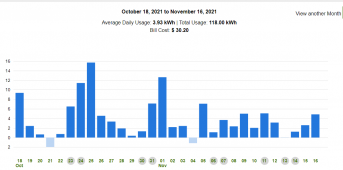
I did have the battery sort of working then, but I had to manually start the charge cycles and it did not self track the power. But I was still able to time shift about 10 KWHs from noon time to the evening. So some of the improvement is probably due to the PLC controlling the XW-Pro, but this is a lot more than that. The weather may also have a little to do with it, but still, this seems huge.
Here is the first half of the same time period so far this year.

The 29th should also be exporting a bit, but the data is delayed for some reason. So I am using 7 KWHs less each day. It just does not seem possible, not that I am complaining.
Oh, we also did get a new dryer. The old one was also gas, so the difference is really just going to a more efficient motor to spin the drum. And since it holds more, we do less loads, but even that is not enough for this difference. I am thinking, maybe it got warm enough on those two bad days that the A/C ended up kicking on??? If the inside temp goes over 81F, it will switch to A/C mode. It has to get pretty hot out for that.
I am 2 weeks into my next So Cal Edison billing cycle. Last year, I had a $120 electric bill for Oct. - Nov. but so far, I am averaging -3 KWHs per day for the first 2 weeks. I only used some grid power on 2 days when we had heavy clouds. It has been getting cold enough at night that my furnace has been kicking on. It looks like it draws 10 amps when the hot surface igniter is on, then drops to just 5 amps after the gas is lit. Last year, without the DC panels, this was causing me to consume 2 to 4 KWHs each day. I would have expected the extra panels to just get me close to zero, but it has pushed it into negative. I am not sure why it seems to be more productive than the numbers suggest. I am only getting 3,000 to 4,000 watt hours a day from the new DC panels, but my So Cal Edison consumption appears to have dropped almost 7,000 watts hours a day from last year. The only real difference is that my son is not here, he is now at college. Was he really using another 3 to 4 kilowatt hours a day? He would leave his TV on all day, and he had a PC and XBOX in his room too. I guess it's possible. Here is last years Oct. to Nov. consumption from SCE.

I did have the battery sort of working then, but I had to manually start the charge cycles and it did not self track the power. But I was still able to time shift about 10 KWHs from noon time to the evening. So some of the improvement is probably due to the PLC controlling the XW-Pro, but this is a lot more than that. The weather may also have a little to do with it, but still, this seems huge.
Here is the first half of the same time period so far this year.

The 29th should also be exporting a bit, but the data is delayed for some reason. So I am using 7 KWHs less each day. It just does not seem possible, not that I am complaining.
Oh, we also did get a new dryer. The old one was also gas, so the difference is really just going to a more efficient motor to spin the drum. And since it holds more, we do less loads, but even that is not enough for this difference. I am thinking, maybe it got warm enough on those two bad days that the A/C ended up kicking on??? If the inside temp goes over 81F, it will switch to A/C mode. It has to get pretty hot out for that.
FWIW, my home office uses about 3.5kWh/day with the lights off and no "projects" running. It can roughly double that with long days and/or doing various little projects.I am only getting 3,000 to 4,000 watt hours a day from the new DC panels, but my So Cal Edison consumption appears to have dropped almost 7,000 watts hours a day from last year. The only real difference is that my son is not here, he is now at college. Was he really using another 3 to 4 kilowatt hours a day?
GXMnow
Solar Wizard
- Joined
- Jul 17, 2020
- Messages
- 2,713
Here are the plots for what my system did on Oct 31, 2022.
Enphase PV Solar production...
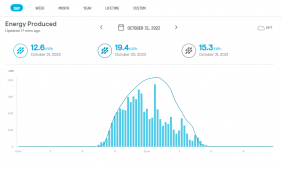
The bars are the current day, and the line over the top is how it did the day before. You can see how the clouds rolled in after 9 am. Production dropped by about 1/3.
Here is what the XW-Pro battery did with the PLC controlling it...
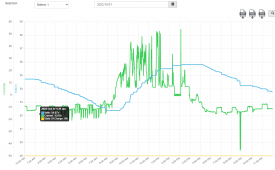
Since production was good the day before, the battery was powering the house all the way until the sun came up. It was discharging into the inverter at 9 to 15 amps. Then after 8 am, PV solar started taking some of the load, and by 8:50 am, it switched to charging and battery voltage started to climb after 9:10 am. All the places that charge current falls to 7 amps, means the solar production was falling below 400 watts. When that happens, the battery voltage stops climbing. About 2:30 pm, the solar production was not keeping up with the loads, and the PLC turned charging off completely. It turned it back on again for a little after 3 pm. Battery voltage didn't even make it to 56 volts, full charge is 57 volts. At 4 pm, charge current is turned off, no matter how much the PV is producing. The XW starts pulling current from the battery to provide power to the house to try and keep the grid at zero current. I actually do have a little offset built in, so it leans a little to exporting power. Because of the fairly large 1% charge current steps, I have it seek to 100 watts of export. A 1% change is about 70 watts. So if the export exceeds 100 watts, increasing the charge current 1% drops the export to 30 watts. If export falls below 20 watts, it reduces the charge current 1 %, so it jumps to 90 watts of export. I leave the window a little bigger, and I have adjusted the values to make it hold more stable and not keep flipping up an back all the time.
Looking at those 2 graphs, it is obvious that the energy from the PV panels is moving a lot with passing clouds. The Enphase report is only showing the average production for each 15 minute time slice, but the XW graphs shows each minutes, and my system is adjusting the current every 5 seconds. Yes it is over kill, but I do it to be able to respond to load changes. The microwave oven is a good example. It may only run for 1 minute, but it pulls 1,600 watts. The only way the XW knows it has come on is that my PLC sees the power jump in the main panel. And it only sees that when it asks for a measurement. That only happens every 5 seconds. So I am consuming grid power until I take a reading and tell the system so compensate for the power change. The same happens again when the over turns back off. It starts exporting that 1,500 watts until the PLC checks and sees the power draw dropped. Then it commands the XW to reduce export again. So the 5 second polling works well, without being too crazy. If I polled much slower, it might completely miss a short load like the microwave. Or it could miss a cloud going over and cutting solar production also.
The end result is the power consumption from So Cal Edison. Here is the same day, with their hourly power use readings...
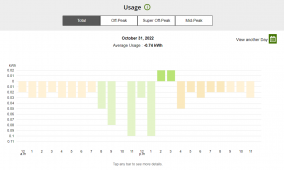
Because the power peak is so small, the graph scales it up to still fill the height. Look at the left side. My peak export power only hit 0.1 KW or just 100 watts average for the 11 am and 1 pm hours. That is when the sun is shining and the PLC is adjusting the charging. The 2 pm and 3 pm bars show that when the solar production tanked to nothing, I ended up using 0.02 KW from the grid. Yes, that is just 20 watts for 2 hours. At 4 pm, I stopped all charging, even when the sun did poke out again. But it really was not much, hitting just 50 watts of export. From 5 pm, all the way to the next morning (just like this morning) the house runs on the battery and I have it leaning a tick to export, pushing out 20 or 30 watts out to the grid for 15 hours. So all night, I exported a whopping total of 400 watt hours from battery to grid. That is about what it takes to get credit to cover the connection charges and taxes.
This was a bad production day with a lot of clouds, and it managed to cover it. The extra 2 kilowatt hours from the DC panels certainly helped make it happen. But as you can't see, these graphs do not show that DC production at all. On a day with better sun, the battery will become fully charged before 3 pm, and then the extra solar exports a lot more. It can even export quite a bit after 4 pm, getting credit at the higher rate. But none of that is from battery. It is only when solar power is exceeding consumption, AND the battery is already full, or it's after 4 pm, and exporting is worth more than charging.
Enphase PV Solar production...

The bars are the current day, and the line over the top is how it did the day before. You can see how the clouds rolled in after 9 am. Production dropped by about 1/3.
Here is what the XW-Pro battery did with the PLC controlling it...

Since production was good the day before, the battery was powering the house all the way until the sun came up. It was discharging into the inverter at 9 to 15 amps. Then after 8 am, PV solar started taking some of the load, and by 8:50 am, it switched to charging and battery voltage started to climb after 9:10 am. All the places that charge current falls to 7 amps, means the solar production was falling below 400 watts. When that happens, the battery voltage stops climbing. About 2:30 pm, the solar production was not keeping up with the loads, and the PLC turned charging off completely. It turned it back on again for a little after 3 pm. Battery voltage didn't even make it to 56 volts, full charge is 57 volts. At 4 pm, charge current is turned off, no matter how much the PV is producing. The XW starts pulling current from the battery to provide power to the house to try and keep the grid at zero current. I actually do have a little offset built in, so it leans a little to exporting power. Because of the fairly large 1% charge current steps, I have it seek to 100 watts of export. A 1% change is about 70 watts. So if the export exceeds 100 watts, increasing the charge current 1% drops the export to 30 watts. If export falls below 20 watts, it reduces the charge current 1 %, so it jumps to 90 watts of export. I leave the window a little bigger, and I have adjusted the values to make it hold more stable and not keep flipping up an back all the time.
Looking at those 2 graphs, it is obvious that the energy from the PV panels is moving a lot with passing clouds. The Enphase report is only showing the average production for each 15 minute time slice, but the XW graphs shows each minutes, and my system is adjusting the current every 5 seconds. Yes it is over kill, but I do it to be able to respond to load changes. The microwave oven is a good example. It may only run for 1 minute, but it pulls 1,600 watts. The only way the XW knows it has come on is that my PLC sees the power jump in the main panel. And it only sees that when it asks for a measurement. That only happens every 5 seconds. So I am consuming grid power until I take a reading and tell the system so compensate for the power change. The same happens again when the over turns back off. It starts exporting that 1,500 watts until the PLC checks and sees the power draw dropped. Then it commands the XW to reduce export again. So the 5 second polling works well, without being too crazy. If I polled much slower, it might completely miss a short load like the microwave. Or it could miss a cloud going over and cutting solar production also.
The end result is the power consumption from So Cal Edison. Here is the same day, with their hourly power use readings...

Because the power peak is so small, the graph scales it up to still fill the height. Look at the left side. My peak export power only hit 0.1 KW or just 100 watts average for the 11 am and 1 pm hours. That is when the sun is shining and the PLC is adjusting the charging. The 2 pm and 3 pm bars show that when the solar production tanked to nothing, I ended up using 0.02 KW from the grid. Yes, that is just 20 watts for 2 hours. At 4 pm, I stopped all charging, even when the sun did poke out again. But it really was not much, hitting just 50 watts of export. From 5 pm, all the way to the next morning (just like this morning) the house runs on the battery and I have it leaning a tick to export, pushing out 20 or 30 watts out to the grid for 15 hours. So all night, I exported a whopping total of 400 watt hours from battery to grid. That is about what it takes to get credit to cover the connection charges and taxes.
This was a bad production day with a lot of clouds, and it managed to cover it. The extra 2 kilowatt hours from the DC panels certainly helped make it happen. But as you can't see, these graphs do not show that DC production at all. On a day with better sun, the battery will become fully charged before 3 pm, and then the extra solar exports a lot more. It can even export quite a bit after 4 pm, getting credit at the higher rate. But none of that is from battery. It is only when solar power is exceeding consumption, AND the battery is already full, or it's after 4 pm, and exporting is worth more than charging.
GXMnow
Solar Wizard
- Joined
- Jul 17, 2020
- Messages
- 2,713
I just went and checked again to be sure I had the current numbers.


This is rounded off, and estimates the taxes on just buying power. The credit I get back for exported power is a bit less due to the NBC's and taxes etc.
I never exceed the baseline credit, so I like their new way of showing it on the bill. My rate is actually the lower cost rows.
So now, in winter, weekday and weekend rates are the same at $0.24 from 8 am to 4 pm, then up to $0.38 4 pm to 9 pm, and then $0.27 from 9 pm back around to 8 am again. Ideally, I want to only buy at the 24 cent rate. Most days do make it close to 8 am on battery. But I am not going to go crazy on more panels and battery for just the 3 cent savings. But 14 cents difference is decent. And remember, when I sell, I don't get to keep the full 24 cents even. So the saving from using my own power is even a little more than this shows. When I time shift 12 KWHs. from 24 cents to 38 cents, that is $1.68 saved each day. We are now on that rate for 8 months x 30 days = 240 days x $1.68 = just over $400 saved. Then in summer, the weekday rate goes from $0.25 from 9 pm to 4 pm, and then jumps up to $0.45 from 4 pm to 9 pm. So for 80 days, shifting 12 KWHs it saves me about 12 x $0.20 x 80 = About $190 on Summer weekdays, and the weekend is 25 cents to 35 cents. So saving 10 cents for another 12 KWHs for about 30 days is another $36 or so. I should actually do better than this, but it is a decent rough estimate. $400 + $190 + $36 = $626 USD just from the time shifting. The DC panel power is almost all being used at the high rate, and coming in for free, not coming off of the low rate time. That is 3 KWH of power every day for nothing = 3 x $0.40 average cost x 340 days (might not produce a few days, so be honest) = Nearly $400 worth of power. So between the battery doing the time shifting, and the DC panels, I might be chopping around $1,000 off my electric bill each year. Last year with the battery manually charging, to this year with the PLC doing the charging, my bill dropped nearly $700 with nearly $300 of that savings in just one summer month. This is not taking into account how much is being chopped off the bill from all the SilFab / Enphase panel production to begin with. That is 8,000 kilowatt hours a year, but it is all being produced at the cheapest rate, 24 or 25 cents. The battery is tasked with time shifting it to the expensive evening rate. But even at the cheapest rate, that production represents 8,000 x $0.24 = $1,920 worth of electricity.
I know it is really sort of cheating, but as they keep raising the rates, it keeps making the solar power look better and better. Bu I can't help but remember that before I put in the solar panels, my base rate was only $0.17 per kilowatt hour, all day long. It only jumped up to $0.34 if I used more the 400 KWH in a month. My original solar install pay back was calculated by keeping me remaining electric bill at just the base 17 cent rate, as the solar feed would keep from going into the second tier, let alone tier 3. But NOPE! You now have solar panels, so now you get ToU rates that start at 24 cents.
As long as the production is able to keep up with my demand on the battery, there is no need to change how the system operates from summer to winter. In all cases, I just make sure I don't ever charge from 4 pm to 9 pm and try to zero the grid from stored solar power. The only change I might make, and it would also be year round, would be to block it from using any battery power before 4 pm, even when there is no solar production. If production is that bad, like it was doing today, I don't want to use what little battery power I did save up to zero my power meter before 4 pm. But right now, it is still doing that. It is easy to block selling to the AC1 grid input based on time, but it is actually difficult to keep it from covering the loads in the backup panel. If I force it to "Standby" will it keep the transfer relay closed to pass grid power to the output side?
Today, it used some battery power to run backup panel loads from 2:30 to 3:30 because the Enphase solar was not able to keep up. Yesterday, it was making 1,900 watts at 3 pm, today it was only making 100 watts at 3 pm. That is a huge loss of production. I am pretty sure it will easily make it to 9 pm on battery, so it is not that big of a deal, but it may run down and have to use grid power before 8 am tomorrow when the sun should rise. Today, even with these clouds, the Enphase system was still able to make over 14 KWHs, and it is still producing 197 watts at 5:20 pm. The DC panels have made 2,744 watt hours, and it is still making almost 50 watts. All of that 2.7+ KWHs from th DC panels went straight into the batteries. When you take the house load from the Enphase production, that leaves it putting 7.9 KWHs into the battery bank. So I stocked up over 10.5 KWHs to use this evening, even with the clouds. That is a bit lower than a good day, when I can store as much as 16 KWHs, but it's not bad.


This is rounded off, and estimates the taxes on just buying power. The credit I get back for exported power is a bit less due to the NBC's and taxes etc.
I never exceed the baseline credit, so I like their new way of showing it on the bill. My rate is actually the lower cost rows.
So now, in winter, weekday and weekend rates are the same at $0.24 from 8 am to 4 pm, then up to $0.38 4 pm to 9 pm, and then $0.27 from 9 pm back around to 8 am again. Ideally, I want to only buy at the 24 cent rate. Most days do make it close to 8 am on battery. But I am not going to go crazy on more panels and battery for just the 3 cent savings. But 14 cents difference is decent. And remember, when I sell, I don't get to keep the full 24 cents even. So the saving from using my own power is even a little more than this shows. When I time shift 12 KWHs. from 24 cents to 38 cents, that is $1.68 saved each day. We are now on that rate for 8 months x 30 days = 240 days x $1.68 = just over $400 saved. Then in summer, the weekday rate goes from $0.25 from 9 pm to 4 pm, and then jumps up to $0.45 from 4 pm to 9 pm. So for 80 days, shifting 12 KWHs it saves me about 12 x $0.20 x 80 = About $190 on Summer weekdays, and the weekend is 25 cents to 35 cents. So saving 10 cents for another 12 KWHs for about 30 days is another $36 or so. I should actually do better than this, but it is a decent rough estimate. $400 + $190 + $36 = $626 USD just from the time shifting. The DC panel power is almost all being used at the high rate, and coming in for free, not coming off of the low rate time. That is 3 KWH of power every day for nothing = 3 x $0.40 average cost x 340 days (might not produce a few days, so be honest) = Nearly $400 worth of power. So between the battery doing the time shifting, and the DC panels, I might be chopping around $1,000 off my electric bill each year. Last year with the battery manually charging, to this year with the PLC doing the charging, my bill dropped nearly $700 with nearly $300 of that savings in just one summer month. This is not taking into account how much is being chopped off the bill from all the SilFab / Enphase panel production to begin with. That is 8,000 kilowatt hours a year, but it is all being produced at the cheapest rate, 24 or 25 cents. The battery is tasked with time shifting it to the expensive evening rate. But even at the cheapest rate, that production represents 8,000 x $0.24 = $1,920 worth of electricity.
I know it is really sort of cheating, but as they keep raising the rates, it keeps making the solar power look better and better. Bu I can't help but remember that before I put in the solar panels, my base rate was only $0.17 per kilowatt hour, all day long. It only jumped up to $0.34 if I used more the 400 KWH in a month. My original solar install pay back was calculated by keeping me remaining electric bill at just the base 17 cent rate, as the solar feed would keep from going into the second tier, let alone tier 3. But NOPE! You now have solar panels, so now you get ToU rates that start at 24 cents.
As long as the production is able to keep up with my demand on the battery, there is no need to change how the system operates from summer to winter. In all cases, I just make sure I don't ever charge from 4 pm to 9 pm and try to zero the grid from stored solar power. The only change I might make, and it would also be year round, would be to block it from using any battery power before 4 pm, even when there is no solar production. If production is that bad, like it was doing today, I don't want to use what little battery power I did save up to zero my power meter before 4 pm. But right now, it is still doing that. It is easy to block selling to the AC1 grid input based on time, but it is actually difficult to keep it from covering the loads in the backup panel. If I force it to "Standby" will it keep the transfer relay closed to pass grid power to the output side?
Today, it used some battery power to run backup panel loads from 2:30 to 3:30 because the Enphase solar was not able to keep up. Yesterday, it was making 1,900 watts at 3 pm, today it was only making 100 watts at 3 pm. That is a huge loss of production. I am pretty sure it will easily make it to 9 pm on battery, so it is not that big of a deal, but it may run down and have to use grid power before 8 am tomorrow when the sun should rise. Today, even with these clouds, the Enphase system was still able to make over 14 KWHs, and it is still producing 197 watts at 5:20 pm. The DC panels have made 2,744 watt hours, and it is still making almost 50 watts. All of that 2.7+ KWHs from th DC panels went straight into the batteries. When you take the house load from the Enphase production, that leaves it putting 7.9 KWHs into the battery bank. So I stocked up over 10.5 KWHs to use this evening, even with the clouds. That is a bit lower than a good day, when I can store as much as 16 KWHs, but it's not bad.
dougbert
Solar Addict
those rates are HUGH. I knew their rates where awful, but you are the first customer I have seen share the prices. Just wow
My first 1,000 kwh from the grid is 9.4 cents and over 1,000 is 10.5, no TOU at this city owned power company. Small city in utah
but I usually consume some 20 to 30 kwh per month, as my electric range/oven is the only thing on grid and when my battery is fully discharged and the grid does the backup operation
My first 1,000 kwh from the grid is 9.4 cents and over 1,000 is 10.5, no TOU at this city owned power company. Small city in utah
but I usually consume some 20 to 30 kwh per month, as my electric range/oven is the only thing on grid and when my battery is fully discharged and the grid does the backup operation
Last edited:
fromport
Solar Addict
Don't forget when you generate more then you use, the baseline credit will become a COST (negative x negative = positive)I never exceed the baseline credit, so I like their new way of showing it on the bill. My rate is actually the lower cost rows.
eg my tracked charges:

This is just for transport, I use CPA as the generator for electricity
Luckily I have a buffer ;-)
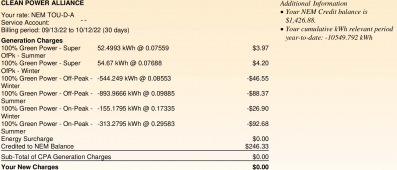
My new winter rates:
Weekday Winter Rates:
Off-Peak: 39 cents from 8 a.m. to 2 p.m., and 8 p.m. to 10 p.m.
Super Off-Peak: 18 cents from 10 p.m. to 8 a.m.
On-Peak: 48 cents from 2 p.m. to 8 p.m.
Weekend Winter Rates:
Weekend Off-Peak: 39 cents per kWh from 8 a.m. to 10 p.m.
Super Off-Peak: 18 cents from 10 p.m. to 8 a.m.
GXMnow
Solar Wizard
- Joined
- Jul 17, 2020
- Messages
- 2,713
In just 1 month, you Exported 1.8 Megawatt hours of energy out to the grid! Wow. That is on top of what you actually used. My entire PV solar array in perfect conditions will fall under 1 megawatt hour of total production in a month, and my total for a year is only 8 megawatt hours. How many watts of solar panel do you have? Assuming you are getting a similar amount of sun as I am, you must have over 14,000 watts of solar panels.
Yes, I saw the "Baseline Credit" as a charge when my month total was negative, but when I looked at how it is calculated, it makes sense. It is a discount off of the electric rate when you use less than a certain "baseline" amount. I still have not been able to find what my baseline limit is, but I think it is about 200 KWHs a month. Might be a little more. What that means is if I consume 40 KWHs at peak time, I am initially charged 47 cents per KWH or 40 x 47 = $18.80. But then they credit me at 9 cents per KWH so 40 x -9 = -$3.60 So the total for that bill would be $15.20 or the same as if they had just charged 47 - 9 = 38 cents x 40 = $15.20 Now when you over produce and get a credit, it has to do the reverse. If you send them 40 KWHs, they credit you $18.80, but then have a charge of $3.60 so the end result is a credit of $15.20 for the exported 40 KWHs. So yes, it does look funny to see a credit turn into a charge, but I see why it is like that.
Here is the same portion of my bill. It looks like you ae on the EV "Prime" rate. So you have the cheaper charging time, but then a more expensive and longer peak rate time.

This is my first month of a new year.
Yes, I saw the "Baseline Credit" as a charge when my month total was negative, but when I looked at how it is calculated, it makes sense. It is a discount off of the electric rate when you use less than a certain "baseline" amount. I still have not been able to find what my baseline limit is, but I think it is about 200 KWHs a month. Might be a little more. What that means is if I consume 40 KWHs at peak time, I am initially charged 47 cents per KWH or 40 x 47 = $18.80. But then they credit me at 9 cents per KWH so 40 x -9 = -$3.60 So the total for that bill would be $15.20 or the same as if they had just charged 47 - 9 = 38 cents x 40 = $15.20 Now when you over produce and get a credit, it has to do the reverse. If you send them 40 KWHs, they credit you $18.80, but then have a charge of $3.60 so the end result is a credit of $15.20 for the exported 40 KWHs. So yes, it does look funny to see a credit turn into a charge, but I see why it is like that.
Here is the same portion of my bill. It looks like you ae on the EV "Prime" rate. So you have the cheaper charging time, but then a more expensive and longer peak rate time.

This is my first month of a new year.
Last edited:
fromport
Solar Addict
Yep, and I try and do everything electric.In just 1 month, you Exported 1.8 Megawatt hours of energy out to the grid! Wow. That is on top of what you actually used.
EV driving, heating, cooling, cooking etc.
I just pushed 17.1kWh back into grid between noon and 1pm ;-) I have about 21kW DC installed atm.My entire PV solar array in perfect conditions will fall under 1 megawatt hour of total production in a month, and my total for a year is only 8 megawatt hours. How many watts of solar panel do you have? Assuming you are getting a similar amount of sun as I am, you must have over 14,000 watts of solar panels.
From SCE:Yes, I saw the "Baseline Credit" as a charge when my month total was negative, but when I looked at how it is calculated, it makes sense. It is a discount off of the electric rate when you use less than a certain "baseline" amount. I still have not been able to find what my baseline limit is, but I think it is about 200 KWHs a month.
Each customer has two baseline allocations, one for summer and one for winter usage. Baseline allocation is the same as the baseline allowance found on the standard residential rate plan. Your allowance can be found by reviewing the “details of your new charges” section of the bill statement. Under “additional information” you will see your summer baseline allowance, your winter baseline allowance, or both, depending on which month’s bill you review.

Tiered Rate Plan
Learn about our Standard rate plan. Our Standard Residential Rate Plan is the basic plan serving most residential customers.
I am in baseline region 9, so 16.5 kWh daily allocation
Imo: the kWh is 1:1 but you always have a transport part from the grid to you of about $0.028/kWhMight be a little more. What that means is if I consume 40 KWHs at peak time, I am initially charged 47 cents per KWH or 40 x 47 = $18.80. But then they credit me at 9 cents per KWH so 40 x -9 = -$3.60
My true-up (annual bill) is in may of each year.So the total for that bill would be $15.20 or the same as if they had just charged 47 - 9 = 38 cents x 40 = $15.20 Now when you over produce and get a credit, it has to do the reverse. If you send them 40 KWHs, they credit you $18.80, but then have a charge of $3.60 so the end result is a credit of $15.20 for the exported 40 KWHs. So yes, it does look funny to see a credit turn into a charge, but I see why it is like that.
My april 2022 SCE bill showed this:

This is what was mentioned on my May SCE bill

In red what they paid me with a check.
$341.69/7911.247= $0.0432/kWh of surplus energy.
Minus the $230.77 that SCE billed me during those 12 months I netted a whopping $111
No natural gas used, I still do have a gas pickup for my business but the Lightning is ordered, delivered Q1 23. Then I will be fossil fuel free.
GXMnow
Solar Wizard
- Joined
- Jul 17, 2020
- Messages
- 2,713
Yup, you have nearly 4.5 times as much PV Solar panel than I did. I added 1 KW of DC panels, and may add another 1 KW soon. But even then, I will only have 6.8 KW of raw STC panel rating. That is just under 1/3 of your system still.
So my annual true up was still a charge. It was about $1,000 the first year, so I got it changed to bill me monthly. Credits still build up, and if I end up with a credit balance, they will roll it to the following year unless I ask in advance for a pay out. Otherwise, the credit just pays for the following month. Before I added the DC panels, I still had to pay a bit for several months. With the extra 1,000 watts, I zeroed an additional month, maybe 2 or even 3 by the math. With 2 KW of DC panels, I just might net out below zero for the year, until I get a plug in car. Based on the performance I have been seeing from the DC panels, the 1,000 watts I have now should end up producing close to 1,500 KWHs in a full year. Doubling that with another set of panels should do the trick.
Yes... Even with the 1:1 credit for the exported power, they still hit us with charges we can't recover. That is why I am trying to make as little power as possible go out and back in through my SCE Power Meter. I do my best to only export extra when I won't be needing it later. I put as much as I can in the batteries, before allowing export past a few watts.
I still can't find my actual baseline amount. I have looked all around on the SCE web site, and read through all that stuff about where to find it. The map they have online has poor resolution, I could be in region 9 or 16. Might be opposite sides of the road, can't tell. Here is that "Details of your new charges" section of my bill...
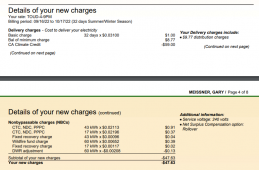
Under "Additional Information" where it should be, it is not listed. Since I am exporting less than 3 KWHs a day, and hardly importing at all, I know I am not even close to the "Baseline Allocation" but it would be nice to know what it is.
I see how they are at using up the NEM credit with all their little charges. I had several months where I averaged exporting every day, and still ended up having to pay a little. I know I am not going to ever make money, but I am really trying to just make it go zero. But I don't want to do it by exporting a crap load around noon. That is the big excuse they are using for the new NEM 3.0 rules to screw over home PV Solar customers. I am minimizing my effect on grid stability and both pushing and drawing as little as possible. If every house did what I am doing, it would vastly reduce the demand on the existing grid. I like having the grid there for when I need some power. So if I end up paying a little here and there, I am cool with it. But when they start adding charges because I have a solar panel that does not ever push power to the grid, something is wrong.
I am waiting for someone from SCE to contact me and ask how I am not using any power from 4 pm to the next morning. And why my PV Solar has essentially stopped exporting. SCE does not know I added the battery system, but the bill does make it seem pretty obvious. I did not permit my battery addition, because I can't move my non UL battery out to a separate fireproof building 5 feet from the house. So until I change to a UL rated battery, I am kind of stuck like this.
So my annual true up was still a charge. It was about $1,000 the first year, so I got it changed to bill me monthly. Credits still build up, and if I end up with a credit balance, they will roll it to the following year unless I ask in advance for a pay out. Otherwise, the credit just pays for the following month. Before I added the DC panels, I still had to pay a bit for several months. With the extra 1,000 watts, I zeroed an additional month, maybe 2 or even 3 by the math. With 2 KW of DC panels, I just might net out below zero for the year, until I get a plug in car. Based on the performance I have been seeing from the DC panels, the 1,000 watts I have now should end up producing close to 1,500 KWHs in a full year. Doubling that with another set of panels should do the trick.
Yes... Even with the 1:1 credit for the exported power, they still hit us with charges we can't recover. That is why I am trying to make as little power as possible go out and back in through my SCE Power Meter. I do my best to only export extra when I won't be needing it later. I put as much as I can in the batteries, before allowing export past a few watts.
I still can't find my actual baseline amount. I have looked all around on the SCE web site, and read through all that stuff about where to find it. The map they have online has poor resolution, I could be in region 9 or 16. Might be opposite sides of the road, can't tell. Here is that "Details of your new charges" section of my bill...

Under "Additional Information" where it should be, it is not listed. Since I am exporting less than 3 KWHs a day, and hardly importing at all, I know I am not even close to the "Baseline Allocation" but it would be nice to know what it is.
I see how they are at using up the NEM credit with all their little charges. I had several months where I averaged exporting every day, and still ended up having to pay a little. I know I am not going to ever make money, but I am really trying to just make it go zero. But I don't want to do it by exporting a crap load around noon. That is the big excuse they are using for the new NEM 3.0 rules to screw over home PV Solar customers. I am minimizing my effect on grid stability and both pushing and drawing as little as possible. If every house did what I am doing, it would vastly reduce the demand on the existing grid. I like having the grid there for when I need some power. So if I end up paying a little here and there, I am cool with it. But when they start adding charges because I have a solar panel that does not ever push power to the grid, something is wrong.
I am waiting for someone from SCE to contact me and ask how I am not using any power from 4 pm to the next morning. And why my PV Solar has essentially stopped exporting. SCE does not know I added the battery system, but the bill does make it seem pretty obvious. I did not permit my battery addition, because I can't move my non UL battery out to a separate fireproof building 5 feet from the house. So until I change to a UL rated battery, I am kind of stuck like this.
GXMnow
Solar Wizard
- Joined
- Jul 17, 2020
- Messages
- 2,713
We finally had a good near cloud free day with cool air. The days are getting shorter, and the sun angle is too low for my panel angle, but this is a good average Fall day here.
This is what the Enphase solar did.
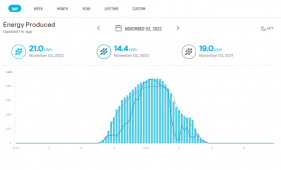
Producing 21 KWHs out of 4.8 KW of panels is a decent 4.375 sun hours. And that is the AC output after the Enphase inverters. Production that day before was weak at just 14.4 KWHs with the clouds, you can se the line graph where production was down in the morning and afternoon. The result was that the battery bank did not reach full charge the day before, and it ran down to the 5.1 volt cut off just 15 minutes before the sun was able to take over. Here is what that looked like in the XW-Pro.

At 7:52 am the inverter went into standby so I used grid power until the battery voltage came back up at 8:02 am. But that was not the Enphase panels. That was the DC charge coming from the NewPowa panels and BougeRV charge controller. The voltage only went up 0.04 volts, but it too the XW out of standby and it helped run the house as the Enphase solar started making some power as well, but not enough on their own. This is one of the first times I have been able to see this happening. The DC panels and the AC panels are working together, driving the loads in the house to keep the grid current at zero. It is not until 8:49 that the Enphase panels alone are making enough power to run the house and have some left over to start charging the battery bank. I see the 7 amp charge start up and the battery voltage starts to climb faster. With both the BougeRV charge controller and the XW in charge mode, the voltage climbs pretty quick. The battery bank ends up getting fully charged to 57 volts at 2:13 pm. The XW goes back into standby, the Enphase inverters are powering the house completely, and the excess AC production is being exported to the grid. At the same time, the BougeRV charge controller is still pushing 10 to 12 amps into the battery bank, but we can't really see any of that here. But the JK BMS does show the current coming in and the voltage did still go up about 0.06 volts. Here is what SCE shows for the consumption this day.
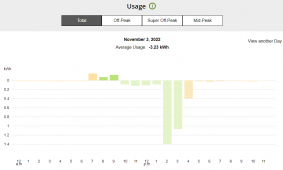
Since the battery did run out, there was a little grid consumption in the 7 am to 9 am area, but it never even reached 200 watts, so the total was easily exported back once the sun did come up. MY small 100 watt export went for 4 hours as the battery charged, then the 2 pm, 3 pm, and 4 pm hours see the extra Enphase energy export. Then the house ran on battery all the way to the next morning, and this time, since the battery was full, it did keep going until the sun was up, and never used any grid power.
The end result was another day of net export. In this case, it was 3.23 KWHs of export total for the day. Here is the fun part. Without the 1,000 watts of DC panels, I would have had to consume grid power on this day. The BougeRV controller did this..
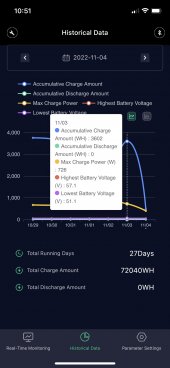
That shows it pushed 3.602 KWHs into the battery bank on this day. Slightly more than my total export to SCE. Without this extra energy, I would have fallen short. And that is exactly what I see, day after day last year. Just that extra 1,000 watts is making the difference between NET export and NET consumption. As the days keep getting shorter, it still won't be enough. The plan is for another 1,000 watts of panels. That should keep me as a net exporter all winter.
This is what the Enphase solar did.

Producing 21 KWHs out of 4.8 KW of panels is a decent 4.375 sun hours. And that is the AC output after the Enphase inverters. Production that day before was weak at just 14.4 KWHs with the clouds, you can se the line graph where production was down in the morning and afternoon. The result was that the battery bank did not reach full charge the day before, and it ran down to the 5.1 volt cut off just 15 minutes before the sun was able to take over. Here is what that looked like in the XW-Pro.

At 7:52 am the inverter went into standby so I used grid power until the battery voltage came back up at 8:02 am. But that was not the Enphase panels. That was the DC charge coming from the NewPowa panels and BougeRV charge controller. The voltage only went up 0.04 volts, but it too the XW out of standby and it helped run the house as the Enphase solar started making some power as well, but not enough on their own. This is one of the first times I have been able to see this happening. The DC panels and the AC panels are working together, driving the loads in the house to keep the grid current at zero. It is not until 8:49 that the Enphase panels alone are making enough power to run the house and have some left over to start charging the battery bank. I see the 7 amp charge start up and the battery voltage starts to climb faster. With both the BougeRV charge controller and the XW in charge mode, the voltage climbs pretty quick. The battery bank ends up getting fully charged to 57 volts at 2:13 pm. The XW goes back into standby, the Enphase inverters are powering the house completely, and the excess AC production is being exported to the grid. At the same time, the BougeRV charge controller is still pushing 10 to 12 amps into the battery bank, but we can't really see any of that here. But the JK BMS does show the current coming in and the voltage did still go up about 0.06 volts. Here is what SCE shows for the consumption this day.

Since the battery did run out, there was a little grid consumption in the 7 am to 9 am area, but it never even reached 200 watts, so the total was easily exported back once the sun did come up. MY small 100 watt export went for 4 hours as the battery charged, then the 2 pm, 3 pm, and 4 pm hours see the extra Enphase energy export. Then the house ran on battery all the way to the next morning, and this time, since the battery was full, it did keep going until the sun was up, and never used any grid power.
The end result was another day of net export. In this case, it was 3.23 KWHs of export total for the day. Here is the fun part. Without the 1,000 watts of DC panels, I would have had to consume grid power on this day. The BougeRV controller did this..

That shows it pushed 3.602 KWHs into the battery bank on this day. Slightly more than my total export to SCE. Without this extra energy, I would have fallen short. And that is exactly what I see, day after day last year. Just that extra 1,000 watts is making the difference between NET export and NET consumption. As the days keep getting shorter, it still won't be enough. The plan is for another 1,000 watts of panels. That should keep me as a net exporter all winter.
fromport
Solar Addict
Electricity rates are a hidden tax here in the People’s Republic of California.those rates are HUGH. I knew their rates where awful, but you are the first customer I have seen share the prices. Just wow
My first 1,000 kwh from the grid is 9.4 cents and over 1,000 is 10.5, no TOU at this city owned power company. Small city in utah
but I usually consume some 20 to 30 kwh per month, as my electric range/oven is the only thing on grid and when my battery is fully discharged and the grid does the backup operation
State has a virtual monopoly on power distribution.
State sets the rates.
State decides who cannot afford the inflated rates and should qualify for discounts to bring net rates back closer to rational levels.
I’m much less tweaked by the minimum monthly charge than I am by the proposed per-kW-of-solar-per-month solar ‘tax’ being proposed.View attachment 119128
I am always temped to use more from SCE when the minimum charge is going to be applied.
If I have to pay them, might as well get some kWh from them for it ;-)
A minimum monthly charge applies to all customers equally and having the grid available for when needed represents a value, whether you end up needing it or not.
Taxing solar customers only for the panels on their roof is the same thing as taxing you on the value of the vegetables you grew in your back yard.
400bird
Solar Wizard
Interesting, these rates shared above don't match my rates with PGE. There are 3 different major power companies, plus other smaller local ones.State has a virtual monopoly on power distribution.
State sets the rates.
The three majors all have their rates set by CPUC (and yes, they are different).Interesting, these rates shared above don't match my rates with PGE. There are 3 different major power companies, plus other smaller local ones.
The minors are inconsequential (the lucky few).
PG&E seems to drop to less differentiated Winter TOU rates than SCE.
At least for now: https://amsunsolar.com/solar-blog/d...8-in-2023-and-heres-what-you-can-do-about-it/
GXMnow
Solar Wizard
- Joined
- Jul 17, 2020
- Messages
- 2,713
I have to agree with 400bird. California electric rates are all over the place. I actually have 3 options just from SCE. I am a bit torn on the "EV" rate option. It has cheaper off peak and super off peak rates, but then the on peak is higher and the fixed monthly charge is also more, even if you use no power. As long as I can keep time shifting away and not using any 4 pm to 9 pm power, I think I could end up saving a little on the EV rate, the added fixed fee just seems wrong to me. And the jacked up peak time rate can really catch you out if the solar does not produce enough.
Between the CPUC and the state taxes, all California utility rates are a bit higher than most of the country. When they shut down the San Onofre nuclear power plant, they smacked us with extra charges to help SCE pay for decommissioning the plant. We had no say in their choice and yet they are making us pay for what I feel was the wrong decision. They spent $680 million to replace the leaking steam generators, then ran the plant only one more year until the new ones were starting to leak. Mitsubishi built faulty steam generators, they should have had to replace them properly under some kind of warranty. Would you scrap your car because a new heater core was leaking again? True, the steam generator was leaking radioactive water into the turbine steam, but it should have been fixed properly. But no, let's just make the customers pay to scrap it all instead. I don't know how the whole legal mess ended with SCE and Mitsubishi. Here is a newspaper story about the mess.

 www.sandiegouniontribune.com
It is crap like this that has caused our electric rates to jump over the years. They screw up and blow a crap load of money, so they jack up rates to cover their loss and make a record profit the next year. And we all end up paying for it.
www.sandiegouniontribune.com
It is crap like this that has caused our electric rates to jump over the years. They screw up and blow a crap load of money, so they jack up rates to cover their loss and make a record profit the next year. And we all end up paying for it.
Between the CPUC and the state taxes, all California utility rates are a bit higher than most of the country. When they shut down the San Onofre nuclear power plant, they smacked us with extra charges to help SCE pay for decommissioning the plant. We had no say in their choice and yet they are making us pay for what I feel was the wrong decision. They spent $680 million to replace the leaking steam generators, then ran the plant only one more year until the new ones were starting to leak. Mitsubishi built faulty steam generators, they should have had to replace them properly under some kind of warranty. Would you scrap your car because a new heater core was leaking again? True, the steam generator was leaking radioactive water into the turbine steam, but it should have been fixed properly. But no, let's just make the customers pay to scrap it all instead. I don't know how the whole legal mess ended with SCE and Mitsubishi. Here is a newspaper story about the mess.

It’s not just the steam generators that failed
Four years after San Onofre shutdown, questions remain about flawed project
400bird
Solar Wizard
Your link calls it out. Rates are not set, but approved by the CPUC.The three majors all have their rates set by CPUC (and yes, they are different).
The minors are inconsequential (the lucky few).
PG&E seems to drop to less differentiated Winter TOU rates than SCE.
At least for now: https://amsunsolar.com/solar-blog/d...8-in-2023-and-heres-what-you-can-do-about-it/
Similar threads
- Replies
- 1
- Views
- 196
- Replies
- 3
- Views
- 307
- Replies
- 3
- Views
- 472
- Replies
- 44
- Views
- 1K



